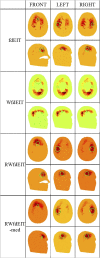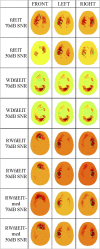Towards continuous EIT monitoring for hemorrhagic stroke patients
- PMID: 37089433
- PMCID: PMC10115159
- DOI: 10.3389/fphys.2023.1157371
Towards continuous EIT monitoring for hemorrhagic stroke patients
Abstract
The practical implementation of continuous monitoring of stroke patients by Electrical Impedance Tomography (EIT) is addressed. In a previous paper, we have demonstrated EIT sensitivity to cerebral hemodynamics, using scalp-mounted electrodes, very low-noise measurements, and a novel image reconstruction method. In the present paper, we investigate the potential to adapt that system for clinical application, by using 50% fewer electrodes and by incorporating into the measurement protocol an additional high-frequency measurement to provide an effective reference. Previously published image reconstruction methods for multi-frequency EIT are substantially improved by exploiting the forward calculations enabled by the detailed head model, particularly to make the referencing method more robust and to attempt to remove the effects of modelling error. Images are presented from simulation of a typical hemorrhagic stroke and its growth. These results are encouraging for exploration of the potential clinical benefit of the methodology in long-term monitoring of hemorrhagic stroke.
Keywords: electrical impedance tomography; image reconstruction; low-noise; multi-frequency; simulation; stroke.
Copyright © 2023 Ouypornkochagorn, Polydorides and McCann.
Conflict of interest statement
The authors declare that the research was conducted in the absence of any commercial or financial relationships that could be construed as a potential conflict of interest.
Figures






Similar articles
-
Sensitivity Analysis Highlights the Importance of Accurate Head Models for Electrical Impedance Tomography Monitoring of Intracerebral Hemorrhagic Stroke.IEEE Trans Biomed Eng. 2022 Apr;69(4):1491-1501. doi: 10.1109/TBME.2021.3120929. Epub 2022 Mar 18. IEEE Trans Biomed Eng. 2022. PMID: 34665718
-
Scalp-Mounted Electrical Impedance Tomography of Cerebral Hemodynamics.IEEE Sens J. 2022 Mar 1;22(5):4569-4580. doi: 10.1109/JSEN.2022.3145587. Epub 2022 Jan 21. IEEE Sens J. 2022. PMID: 35673527 Free PMC article.
-
Design of a microscopic electrical impedance tomography system for 3D continuous non-destructive monitoring of tissue culture.Biomed Eng Online. 2014 Oct 6;13:142. doi: 10.1186/1475-925X-13-142. Biomed Eng Online. 2014. PMID: 25286865 Free PMC article.
-
Advances in electrical impedance tomography-based brain imaging.Mil Med Res. 2022 Feb 28;9(1):10. doi: 10.1186/s40779-022-00370-7. Mil Med Res. 2022. PMID: 35227324 Free PMC article. Review.
-
Data preprocessing methods for electrical impedance tomography: a review.Physiol Meas. 2020 Oct 5;41(9):09TR02. doi: 10.1088/1361-6579/abb142. Physiol Meas. 2020. PMID: 33017303 Review.
Cited by
-
Clinical electromagnetic brain scanner.Sci Rep. 2024 Mar 8;14(1):5760. doi: 10.1038/s41598-024-55360-7. Sci Rep. 2024. PMID: 38459073 Free PMC article.
References
-
- Anas M., Norali A., Rehman M. (2012). Development of a low cost precision blood resistivity measurement device based on Thompson Lampard theorem. Penang, Malaysia: IEEE, 594–597.
LinkOut - more resources
Full Text Sources

